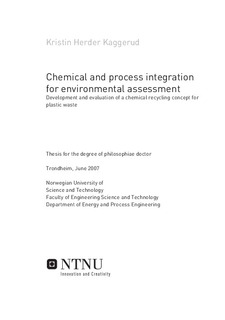| dc.description.abstract | The thesis focuses on systems oriented methods in conceptual design and analysis of chemical processes, both with respect to environmental performance. The areas of process synthesis and process systems engineering offer a considerable number of methodologies and tools for designing integrated production systems, ranging from individual processes to total sites. In this thesis the well established tools, life cycle assessment (LCA) and process integration (PI), have been applied in evaluation and design of sustainable production systems. LCA considers the environmental performance of a process or product (more common) from “cradle to grave”, whereas process integration focus on optimization of energy consumption in a system. In addition, chemical integration and substance flow analysis (SFA) that also aim at sustainability through more efficient use of raw materials and chemicals have been adapted and applied to processes. In the case of chemical integration, a new definition has been proposed that makes it closely related to process integration.
An important concept used in process synthesis, design and optimization of production systems is the so-called superstructure representation. The idea is to include alternative raw materials, alternative processing steps and to some extent alternative products and by-products in a common representation of multiple flowsheets, where the selection of a single flowsheet with corresponding feed and product streams is made (through optimization) by setting binary variables to either zero or one. In this work, the superstructure concept is not used for optimization purposes, but rather to illustrate how a mix of raw materials, a mix of products, by-products and intermediates, as well as a mix of processing steps can be used to obtain maximum utilization of chemicals and energy. In other words, a multi chain chemical complex may result rather than a single production chain focusing on one main product.
The thesis also demonstrates, the benefits of combining process integration and LCA, in particular when the focus is on CO2 emissions and mitigating the global warming problem. LCA sets the scene for process integration by indicating where the largest emissions are generated, while process integration improves the quality of the LCA by delivering better and more consistent data to the LCA study. An algorithm (LCA-PI) for combined use of LCA and process integration has been developed with accompanying models in Excel and HYSYS. Division of the emissions into process and utility waste has proven helpful in tracking of the origin of all emissions. While LCA has been used for a long time to assess the environmental performance of a product that serves a specific function, there are so far few studies where LCA has been used to analyse processes and production systems.
The plastic waste to plastic concept (PtP) has been used as a case study throughout the thesis. The PtP concept is a new concept for chemical recycling of plastic waste back to new plastic materials. In the core PtP concept, plastic waste is chemically converted to synthesis gas in an oxygen operated gasifier. After adjusting the H2/CO ratio in a water gas shift reactor (WGS), the synthesis gas is converted into methanol before olefins are produced by the Hydro/UOP patented methanol to olefins (MTO) process. Olefins are then the building block for several different types of plastic. The concept is flexible both with regard to input (other carbonaceous material) and output (methanol, hydrogen, energy), and intermediate products can be added in order to adjust for scale. By inclusion of other inputs, outputs or intermediates the term “extended PtP concept” is used.
The core PtP concept has been developed and evaluated by use of both traditional systems oriented methods, like process integration and life cycle assessment, and application of the methodologies and the algorithm proposed by the thesis. Further, the same methodologies have been used in development and evaluation of the extended PtP concept, which are able to decrease the greenhouse gas emissions from the plastic waste to plastic concept. | nb_NO |
